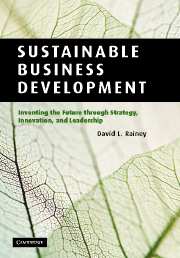Book contents
Part II - Innovation management, life cycle considerations, and insights
Published online by Cambridge University Press: 04 December 2009
Summary
Part II discusses the relationships between SBD and innovation management, and how LCT, life cycle management, and LCA can provide the understanding of opportunities and challenges that is necessary for making significant improvements. SBD and innovation are inexorably linked. Moving toward SBD also requires a broad strategic perspective that LCT and LCA can provide. The first two chapters of Part II (chapters 7 and 8) examine the significant roles of technological innovation and product development in achieving sustainable success. Technological innovation focuses on inventing new or dramatically improved technologies that accentuate positive implications and mitigate negative consequences. Product innovation deals with improving products and applications through incremental change.
Part II includes an overview of LCT and life cycle management, LCA, and the associated methods and techniques. Chapters 9–11 cover the basic methods and techniques and quantitative and qualitative approaches for LCT, life cycle management, and LCA. Discussions include customer and stakeholder needs mapping, benchmarking, gap analysis, and other analytical tools.
- Type
- Chapter
- Information
- Sustainable Business DevelopmentInventing the Future Through Strategy, Innovation, and Leadership, pp. 381 - 384Publisher: Cambridge University PressPrint publication year: 2006



